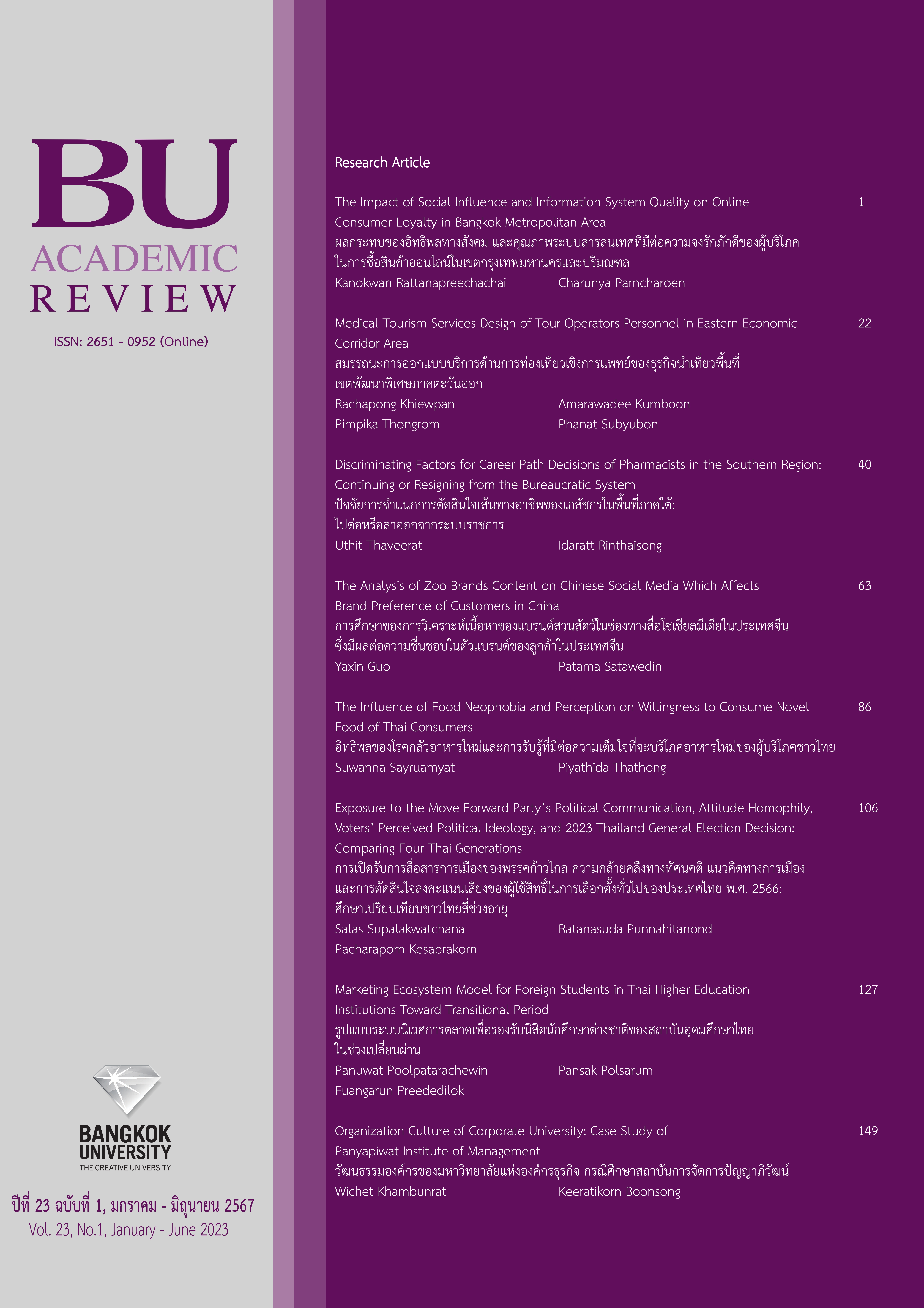Marketing Ecosystem Model for Foreign Students in Thai Higher Education Institutions Toward Transitional Period
Main Article Content
Abstract
This article has two objectives: To present research findings on the current situations and problems on marketing for international students of Thai higher education institutions towards transitional period, and good practices of marketing ecosystem for international students of Thai higher education institutions towards transitional period. This research is based on 8 aspects of marketing mix theory derived from studying related documents and research which includes Program, Price, Place, Promotion, Prestige, People, Premium and Productivity by using mixed methods research. In quantitative research,aquestionnaire was used to inquire the current conditions and problems with 222 undergraduate international students from 6 higher education institutions. The sample was selected by simple random sampling. For a qualitative research, a group of 6 purposively selected key informants using the criteria of being university administrators or people responsible for marketing.
The research results found that the current conditions and problems in all 8 aspects of marketing from the perspective of service users were mostly at a low level of problems, with only 3 issues in marketing promotion aspect having problems at a moderate level which include the attractiveness of the university website, easiness of using university website, and attractiveness & usefulness of university social medias. Another 2 issues regarding premium aspect are attractiveness of university clubs and the quality of accommodation service by university. The findings on current conditions, problems, and good practices of the marketing ecosystem obtained from key informants' interviews cover all 8 aspects, which will be descriptively rewritten to form the overall image of marketing ecosystem model for international students of Thai higher education institutions towards transitional period.
Article Details

This work is licensed under a Creative Commons Attribution-NonCommercial-NoDerivatives 4.0 International License.
The manuscript submitted for publication must be the original version, submitted only to this particular journal with no prior acceptance for publication elsewhere in other academic journals. The manuscript must also not violate the copyright issue by means of plagiarism.
References
Choudaha, R. (2017). Three waves of international student mobility (1999 - 2020). Studies in Higher
Education, 42(5), 825-832.
Dungy, G., & Gordon, S. A. (2010). The development of student affairs. In J. Schuh, S. Jones, & S. Harper
(Eds.), Student Services: A Handbook for the Profession (pp. 6180). San Francisco, CA: Jossey-Bass.
Faul, F., Erdfelder, E., Lang, A.-G., & Buchner, A. (2007). G*Power 3: A flexible statistical power analysis
program for the social, behavioral, and biomedical Sciences. Behavior Research Methods, 39(2), 175–191. doi:10.3758/bf03193146.
Gillespie, C. (2023). 6 key trends playing out in higher education. Retrieved December 6, 2023, from
https://ren-network.com/6-key-trends-playing-out-in-higher-education/
Higher Education Commission Ministry of Education Office. (2007). Krō̜p phǣn ʻudom sưk sot raya yāo
siphā pī chabap thī sō̜ng (Phō̜.Sō̜. 2551 - 2565) [15 Year long-term higher education framework plan no. 2 (2008-2022)]. Bangkok: Higher Education Commission Ministry of Education Office.
Huang I. Y., Raimo V., & Humfrey C. (2016). Power and control: Managing agents for international
student recruitment in higher education. Studies in Higher Education, 41(8), 1333-1354.
Ivy, J. (2008). A new higher education marketing mix: The 7Ps for MBA marketing. The International
Journal of Educational Management, 22(4), 288-299.
Kotler, P. (1997). Marketing management (9th ed.). New Jersey: Prentice-Hall.
Kotler, P., Kartajaya H., & Setiawan, I. (2021). Marketing 5.0: Technology for humanity. Hoboken, New
Jersey: Wiley.
Lumby, J., & Foskett, N. (2016). Internationalization and culture in higher education. Educational
Management Administration & Leadership, 44(1), 95-111.
Noonman, T. (2018). ʻUdom sưksā ʻō̜ mē ri kā ra sam sō̜ ʻong botrīan nī wikrit [American higher
education is in disarray: Crisis escape case study]. Retrieved October 20, 2020, from
https://www.posttoday.com/politic/report/547451
Peungpol, W., & Chantuk, T. (2018). Kānphatthanā khwāmsamphan chœ̄ng sāhēt khō̜ng tūa bǣp
khunnalaksana bandit tō̜ khwāmphưngphō̜čhai phūchai bandit nai ʻutsāhakam 4.0 kō̜ranī sưksā
khwāmkhithen khō̜ng bandit khana witsawakammasāt mahāwitthayālai Narēsūan [Character
model model of graduate on satisfaction of graduate Users in Industry 4.0 case study on
responded graduates in Engineering Faculty, Naresuan University. Journal of Community
Development Research (Humanities and Social Sciences), 11(2), 171-187.
Sandeen, A., & Barr, M. J. (2016). Critical issues for student affairs: Challenges and opportunities (1st ed.). San Francisco, CA: Jossey-Bass.
Srisaard, B. (2002). Kānwičhai bư̄angton (Phim khrang thī 7) [Basic research (7th ed.)]. Bangkok:
Suweeriyasawon.
Tavares, V. (2021). Feeling excluded: International students experience equity, diversity and inclusion.
International Journal of Inclusive Education, 2021, 1–18.
Wongpinanwatthana, W. (2019). Kānchai phāsā Thai nai krabūankān sư̄sān khām watthanatham
khō̜ng naksưksā nānā chāt [The use of thai language in the cross-cultural communication
process of international students]. Kon khaen: Thai Language Department, Faculty of
Humanities and Social Sciences, Kon khaen University.


